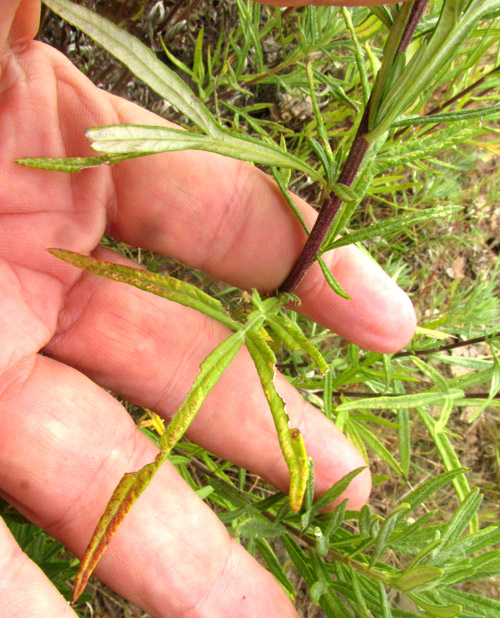Excerpts from Jim Conrad's
Naturalist Newsletter
entry dated January 11, 2023, issued from near Tequisquiapan, elevation about 1,900m (6200 ft), ~N20.57°, ~ W99.89°, Querétaro state, MÉXICO
MEXICAN SILVER WORMWOOD
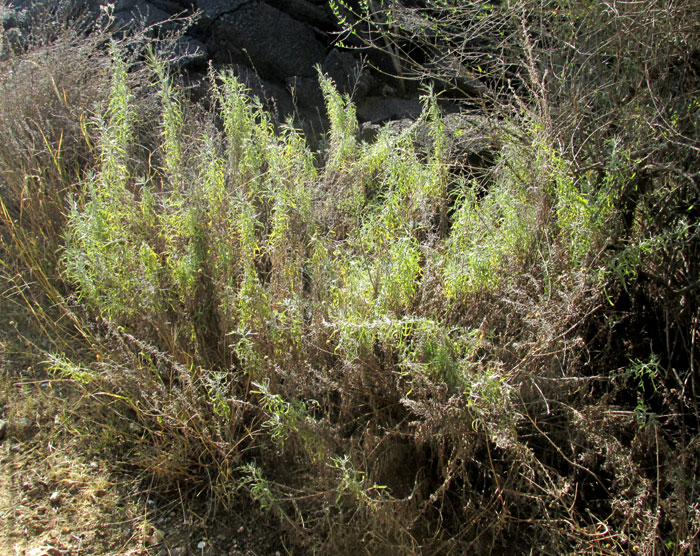
During the early dry season after a rainy season that didn't develop as it has in the past, in a disturbed area at the edge of a small village where things are dumped the way that here all kinds of things are dumped in all kinds of places, the perennial, bushy shrub shown above was drying up and haggard looking. Incongruously forming a dense, healthy-looking and apparently expanding population about the size of a one-car garage next to a truckload of broken-up asphalt pavement, it was the only population I've seen of this species in this area. Very possibly it'd found its way there as dumped refuse. Up close, inflorescences could be seen:

Each of the egg-shaped items dangling on offshoots of the stem is a flowering head, better seen below:
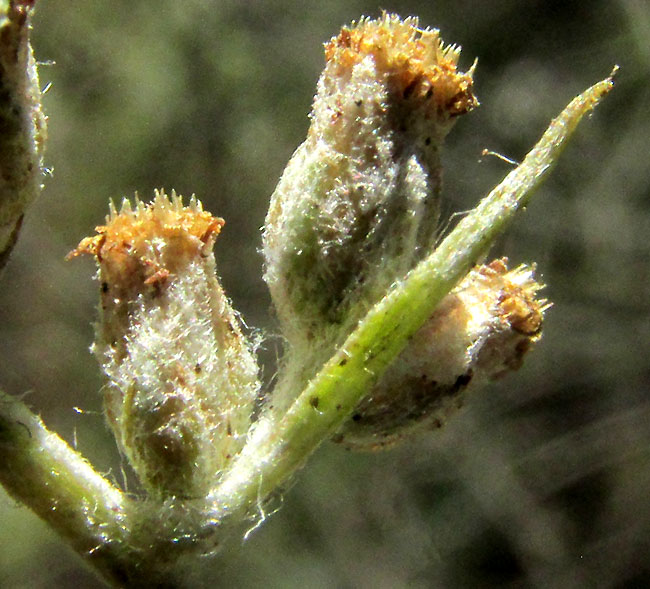
With numerous cylindrical disc florets crammed within urn-shaped involucres, our plant is clearly a member of the enormous Aster or Composite Family, the Asteraceae. In that family, with so many genera and species to plow through, for identification, you must pay very close attention to details. Above, vital field marks include that the flower heads produce no petal-like ray florets radiating from the heads' peripheries, which most species in the family do. The heads are arranged along a stem-like rachis -- in "racemiform arrays," meaning that each head has its own little stalk attaching to the rachis. The heads are exceptionally small, only about 2mm tall (0.08 inch). And, the entire plant, except the florets' corollas, is covered with white, cobwebby hairs:
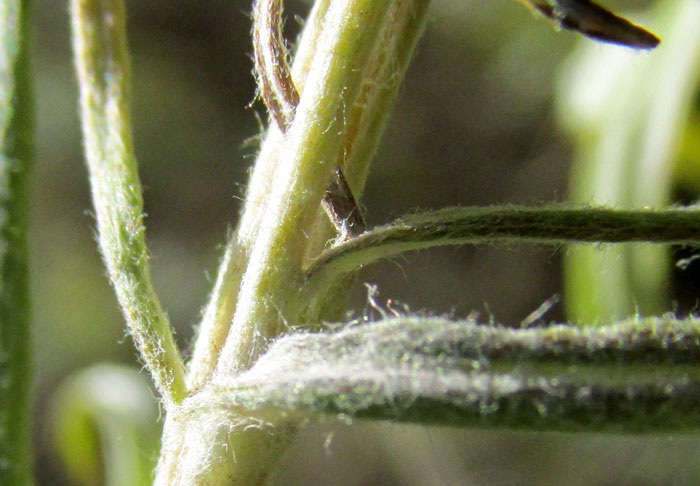
Something not apparent unless you look closely is that larger stem leaves usually bear very slender side-lobes:
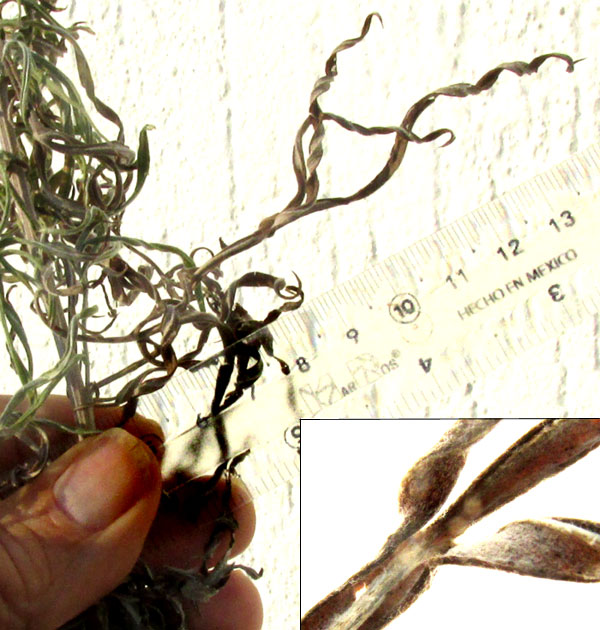
Above, spiraling off into the image's top, right corner, you see a leaf about 10cm long (4 inches), with two very slender side lobes. The inset at the picture's bottom, right shows how the lobes arise from the rachis, and how the blade's margins curl under.
Several Aster Family genera produce features like these and -- especially because the flowering heads were so tiny that in the field I couldn't see details of the fruit, pappus, paleae and such -- after seeing all the above field marks I still couldn't recognize the plant. Hoping to photograph a broken-open flowering head stuck on a fingertip with saliva, when my tongue touched the finger to moisten it, because I'd been handling the plant, I tasted one of the plant's most important field marks. My mouth was filled with a strong, medicinal taste of the kind I know well from brewing "tea" from wormwood leaves when I need to de-worm my intestines, which always is a good idea if you go barefooted in the tropics.
The medicinal-tasting wormwoods I know of belong to the genus Artemisia. Looking in that genus for Artemisia species occurring in this area, there were three species, of which one of our earlier-encountered species, much more common here, Artemisia absinthium, was one. Of the two other species, our plant not being an annual, turned out to be ARTEMISIA LUDOVICIANA ssp. MEXICANA. This is yet another taxon first collected scientifically by Humboldt and Bonpland (#4359) during their passage through central Mexico in 1803 and 1804. You can see their collection listed in the actual publication of 1826, where it was introduced to science under the name Artemisia mexicana. One of several English names for Artemisia ludoviciana is Silver Wormwood.
Maybe eight or nine subspecies of Artemisia ludoviciana are recognized. The only subspecies listed for our highland, semi-arid, central Mexico location is mexicana, this subspecies arising when the Artemisia ludoviciana collected by Humboldt and Bonpland's Artemisia mexicana was lumped into Artemisia ludoviciana. Naturally our mexicana subspecies in English must be called Mexican Silver Wormwood. The species as a whole extends from most of the forested region of Canada south all through the US and Mexico, to Nicaragua, plus it's invasive in much of Eurasia and parts of Australia. However, our subspecies mexicana occurs from the central US south to Nicaragua. The mexicana subspecies distinguishes itself from the others by its stem leaves usually bearing very narrow side lobes, the flowering heads being presented in raceme-like arrays, and the leaf margins curling under, or being "revolute."
With the leaves' strong medicinal taste you can imagine that this species is very important in the traditional Mexican pharmacopoeia. The fascinating Atlas de las Plantas de la Medicina Tradicional Mexicana, which names it Estafiate, lists about 28 other names it goes by in various regions. The Flora del Bajío tells us that it's often cultivated in family gardens. As such, its extensive area of distribution may reflect a history of people carrying the species with them as they moved about.
The Atlas tells us that ancient indigenous people regarded our plant as divine, and during ceremonies honoring the gods of water and salt, dancers wore garlands of Artemisia ludoviciana on their heads and onlookers held the herb in their hands.
Traditionally, Artemisia ludoviciana has been used for nearly any stomach problem, including gas and diarrhea. The branches are cooked in water, then the tea is drunk. The tea by itself can be drunk for intestinal worms, or accompanied by epazote, the other wormwood species, and/or Peppermint. Other uses are too numerous to mention.
But, does this herbal remedy really work? The 2022 publication by José Luis Gálvez Romero entitled "Antimycobacterial, cytotoxic, and anti-inflammatory activities of Artemisia ludoviciana" concluded that "We showed that the ethanol extract of A. ludoviciana possessed antimycobacterial activity and could potentially be used to supplement the antibiotic treatment of TB." Numerous earlier publications also supported its use against disease organisms.
With regard to my use of it against intestinal worms, Samuel Estrado-Soto and others in a 2012 work entitled "Relaxant effects of Artemisia ludoviciana on isolated rat smooth muscle tissues" found for the plant that "all extracts induced a significant concentration- and partial endothelium-dependent vasorelaxant activity," the term "vasorelaxation" referring to the reduction of vascular tension. In other words, a tea of our plant might cause worms in the gut to release their hold on the intestinal wall and pass from the body, which has been my experience.
Entry dated November 9, 2023, from notes taken at Cascadas de La Piedad waterfall 3kms NW of the community of San Pablo, municipality of Almeaco de Bonfil; N20.101°, W100.004°, elevation 2360 meters (7750ft); extreme southern Querétaro state, MÉXICO
A FRESHER WORMWOOD
At another time and place, another Silver Wormwood turned up next to a stream running across volcanic pink andesite bedrock. Here, having plenty of water and a looser soil, the species shows a different appearance:
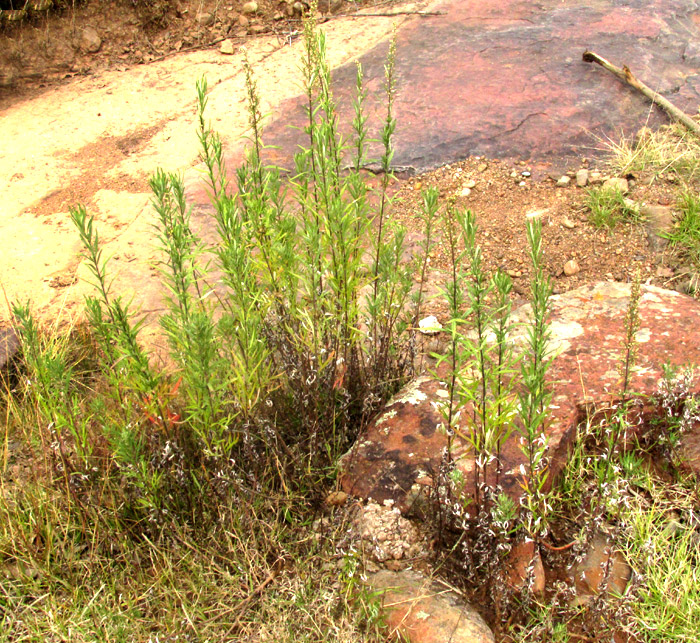
Here's a stem's flowering upper part:
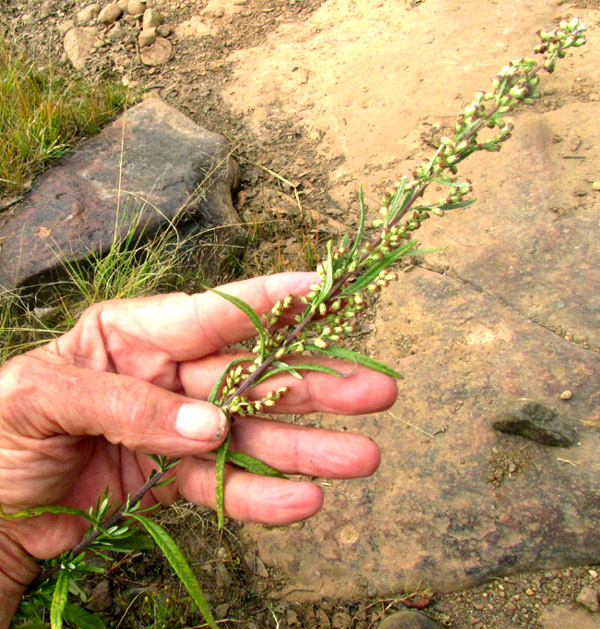
And here are leaves not yet dried out:
